A rare 'reversed' sunspot may spark bright auroras tonight
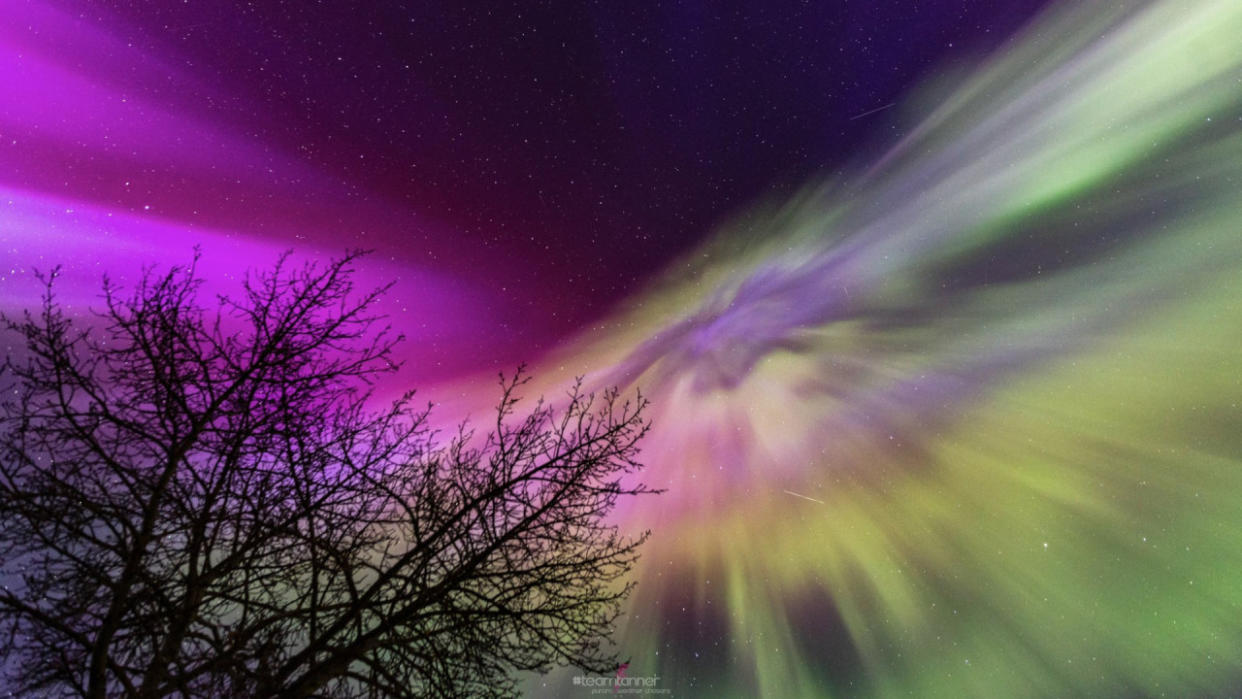
On Tuesday, a rare 'reversed-polarity' sunspot blasted out yet another solar flare. The solar storm that erupted along with it could cause the auroras to shine brighter and extend farther south than usual on Thursday night.
On the afternoon of May 9, sunspot AR3296, which has been crackling with activity for days, blasted out two moderate-strength solar flares in quick succession. At the same time, the release of energy caused a coronal mass ejection to erupt into space. This follows two other smaller CMEs that erupted toward Earth on Sunday.
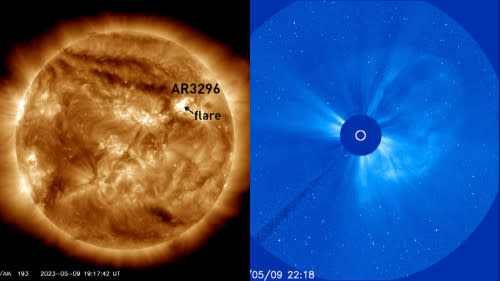
The flare from sunspot AR3296 on May 9 is shown here (left panel), as seen by NASA's Solar Dynamics Observatory (SOHO). On the right, the bright 'cloud' towards the top right of the panel, is the CME expanding away from the solar flare, as captured by the coronagraph instrument on the NASA/ESA Solar and Heliospheric Observatory (SOHO). Credit: NASA/ESA/Scott Sutherland
Coronal mass ejections, aka solar storms, are immense clouds of charged solar particles that expand away from the Sun, typically following a solar flare. If a solar storm sweeps past us, the magnetic field carried by the cloud interacts with Earth's magnetic field, causing a disturbance known as a geomagnetic storm. Space weather forecasters rank these storms on a five-point scale, from G1 (minor) to G5 (extreme). The stronger the geomagnetic storm, the more likely we'll see bright displays of the Northern Lights, the farther south those displays will extend, and the greater the possibility that we could see impacts to orbiting spacecraft or power grids on the ground.
According to NOAA's Space Weather Prediction Center, there is already a chance for a G2 (moderate) geomagnetic storm to develop Wednesday night due to the effects of the solar storms from Sunday.
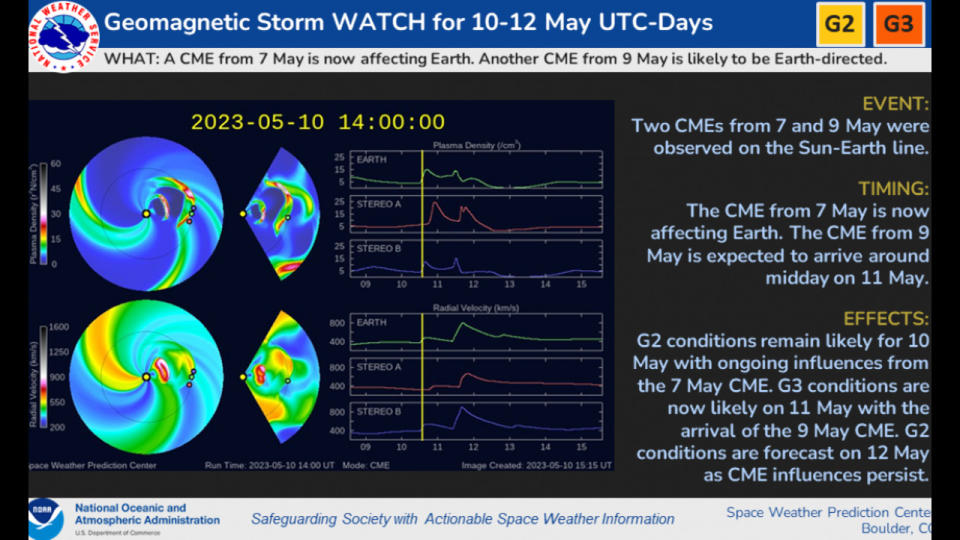
This graphic shows NOAA's space weather model that predicts the progress of solar storms as they expand away from the Sun, along with the expected impacts over the next two days due to the edge of the incoming solar storms affecting Earth as they pass by. Credit: NOAA SWPC
When the CME from Tuesday arrives, its effects could combine with the residual impacts from the previous solar storms to produce an even stronger, G3 (strong) geomagnetic storm on Thursday.
"Forecasters predict a component of this CME will arrive at Earth by midday on 11 May as a G3 (Strong) geomagnetic storm while the bulk of the eruptive material passes ahead and north of Earth's orbit," SWPC wrote. "G2 (Moderate) storming is likely into 12 May with ongoing CME influences."
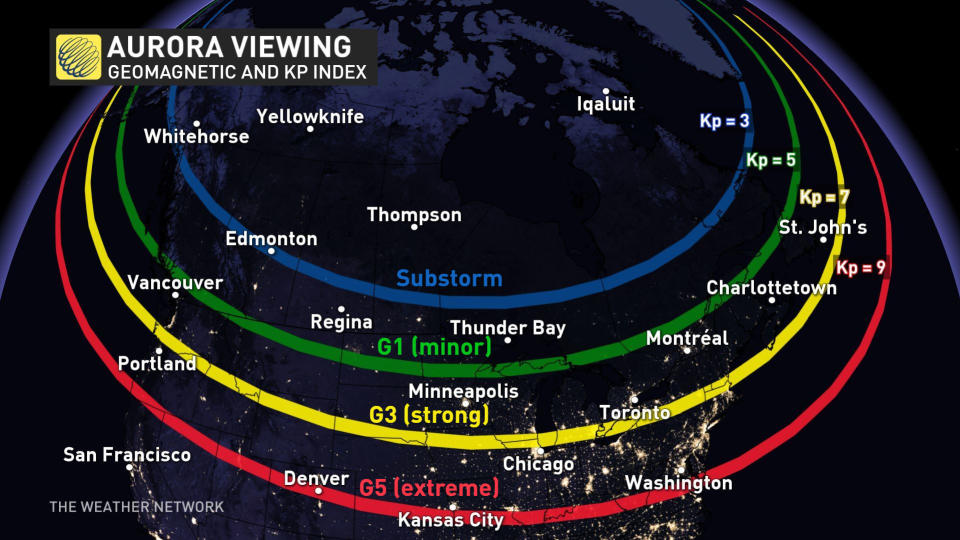
Auroras from a G2 geomagnetic storm typically extend far enough south to be visible along the northern horizon for anyone located about halfway between the green and yellow lines on the above map. During a G3 geomagnetic storm, this pushes down as far as the yellow line, potentially producing aurora displays visible across almost all of Canada.
READ MORE: Powerful solar storm generates dazzling auroras across Canada
Will we see them?
Clear skies are essential to see the Northern Lights. Check your weather forecast for your local sky conditions. The map below shows the expected cloud cover across Canada overnight on Thursday night.
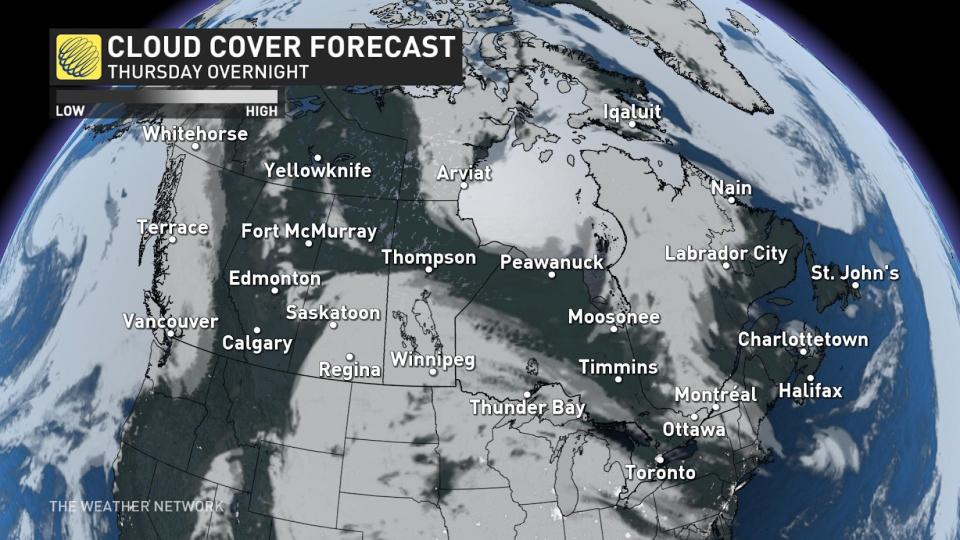
Also, urban light pollution spoils the ability of the human eye to see fainter objects and light displays in the night sky. Thus, spotting the auroras from in or near a large urban centre can be very challenging. To maximize your chances of seeing them, getting as far away from city lights as possible is best.
A solar rarity
Space weather scientists call AR3296 a 'reversed-polarity' sunspot.
According to Dr. Tony Phillips, from spaceweather.com, the magnetic field of this sunspot is the reverse of what it should be. Other sunspots in the Sun's northern hemisphere right now have their magnetic field oriented so that as they travel across the face of the Sun, their leading edge has positive polarity, and the trailing edge has negative polarity. Sunspot AR3296's magnetic field is reversed from that, with its leading edge negative and its trailing edge positive.
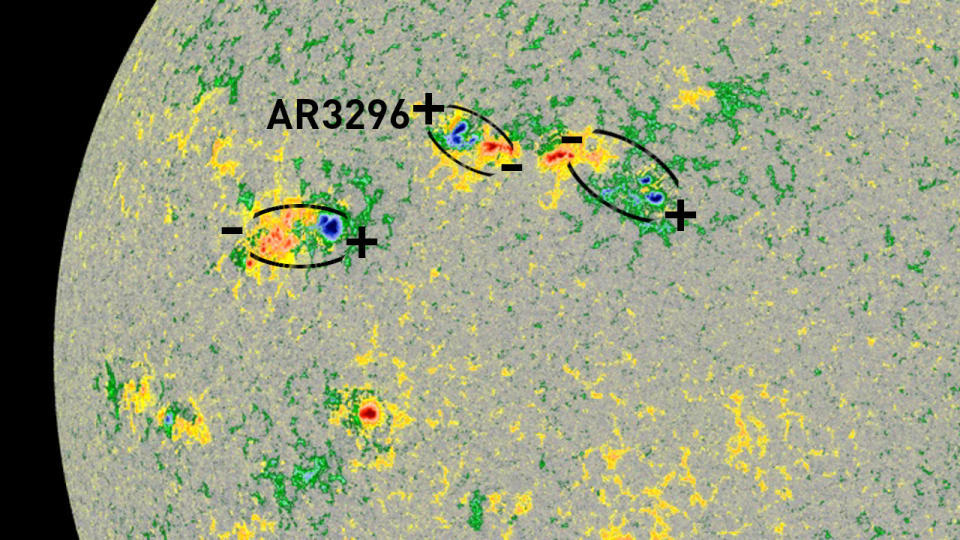
This view of the Sun's surface from May 5, 2023, shows the magnetic polarity of different regions. Blue is positive polarity, while red is negative polarity. The notations added link the polarities across specific active regions (sunspots). AR3296's polarity is reversed compared to the other sunspots in the view. Credit: NASA/SDO/Scott Sutherland
Phillips says that only about 3 per cent of sunspots behave in this way.
"In most ways, reversed polarity sunspots are totally normal. They have about the same lifespan and size as ordinary sunspots," Phillips wrote. "In one important way, however, they are different. According to a 1982 survey by Frances Tang of the Big Bear Solar Observatory, reversed polarity sunspots are more than twice as likely to develop complex magnetic fields, in which + and – are mixed together. Reversed polarity sunspots are therefore more likely to explode."
(Thumbnail image courtesy Tree Tanner and Dar Tanner (TeamTanner))

